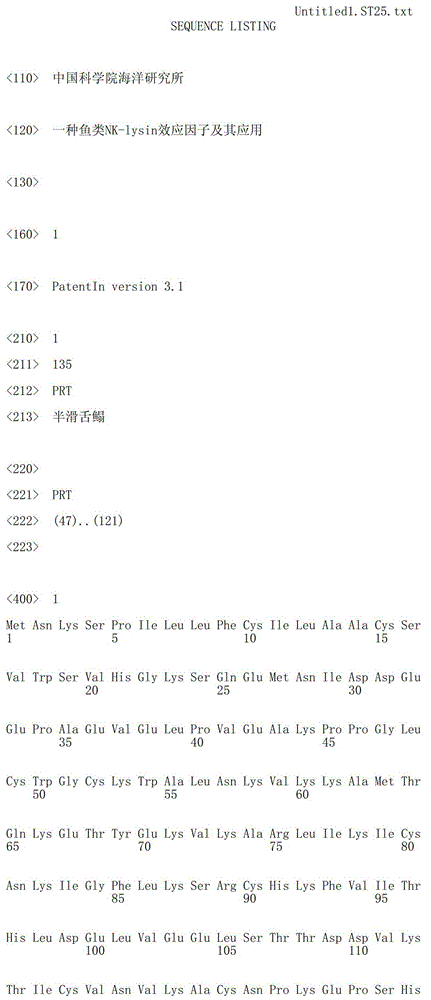Fish natural killer (NK)-lysin effective factors and application method thereof
An effector and fish technology, applied in the field of molecular biology, can solve the problems of function and application that are yet to be studied, and achieve the effect of improving the ability of anti-virus and anti-bacterial infection
- Summary
- Abstract
- Description
- Claims
- Application Information
AI Technical Summary
Problems solved by technology
Method used
Image
Examples
Embodiment 1
[0018] The NK-lysin of the present invention is the amino acid sequence in SEQ ID No.1 of the sequence table.
[0019] The sequence listing SEQ ID No.1 is:
[0020] MNKSPILLFCILAACSVWSVHGKSQEMNIDDEEPAEVELPVEAKPPGLCWGCKWALNKVKKAMTQKETYEKVKAR LIKICNKIGFLKSRCHKFVITHLDELVEELSTTDDVKTICVNVKACNPKEPSHLLFYPNN
[0021] (a) Sequential features:
[0022] ●Length: 135 (effective area 47-121)
[0023] ●Type: amino acid sequence
[0024] ●Chain type: single chain
[0025] ●Topological structure: linear
[0026] (b) Molecule Type: Protein
[0027] (c) Assumption: No
[0028] (d) Antisense: No
[0029] (e) Original source: tongue sole
[0030] Structural features: The protein is expected to contain a Saposin B functional domain (amino acids 47-121).
Embodiment 2
[0032] Construction of NK-lysin expression plasmid pCNK1:
[0033] The cDNA of tongue sole was used as a template and PCR amplification was carried out with primers F1 and R1. The PCR conditions are: 94°C for 60s to pre-denature template DNA, then 94°C for 40s, 50°C for 60s, 72°C for 60s, after 5 cycles, change to 94°C for 40s, 58°C for 60s, 72°C for 60s, after 30 cycles and then repeat at 72°C. ℃ extension reaction 7-10min. PCR products were purified with corresponding kits from Tiangen. The expression vector pIRES2-EGFP (purchased from Clontech, USA) was digested with the restriction endonuclease SmaI to recover a 5kb fragment, which was ligated with the above-mentioned purified PCR product with T4 DNA ligase, and the ligation solution was transformed into Escherichia coli DH5α. Cultured on LB medium containing kanamycin (50ug / ml) for 18-24 hours, screened transformants to extract plasmid, named pCNK1. DNA sequencing analysis proved that pCNK1 is an expression plasmid con...
Embodiment 3
[0036] Application of NK-lys in expression plasmid pCNK1
[0037] Step 1) Plasmid injection
[0038] Dilute the pCNK1 of the above-mentioned Example 2 to 200ug / ml in PBS, which is the pCNK1 dilution. Twenty tongue soles (about 5.1 g in weight) were randomly divided into 4 groups, 5 in each group. These 4 groups are named A, B, C and D respectively. Each fish in groups A and C was injected with 50 ulp of CNK1 dilution, and each fish in groups B and D (control group) was injected with 50 ul of PBS.
[0039] The composition of the PBS is by weight percentage: 0.8% NaCl, 0.02% KCl, 0.358% Na 2 HPO 4 .12H 2 O, 0.024% NaH 2 PO 4 , and the balance is water.
[0040] Step 2) Bacteria and virus suspension preparation
[0041] Cultivation of Vibrio anguillarum C312 to OD in LB medium 600 0.8, then centrifuge (5000g, 4°C, 10min), collect the cells, suspend them in PBS to a final concentration of 1 x 10 7 cfu / ml is Vibrio eelium suspension. The cytomegalovirus RBIV-C1 (see Zha...
PUM
 Login to View More
Login to View More Abstract
Description
Claims
Application Information
 Login to View More
Login to View More - R&D
- Intellectual Property
- Life Sciences
- Materials
- Tech Scout
- Unparalleled Data Quality
- Higher Quality Content
- 60% Fewer Hallucinations
Browse by: Latest US Patents, China's latest patents, Technical Efficacy Thesaurus, Application Domain, Technology Topic, Popular Technical Reports.
© 2025 PatSnap. All rights reserved.Legal|Privacy policy|Modern Slavery Act Transparency Statement|Sitemap|About US| Contact US: help@patsnap.com


